Maytag MFF2558FEZ00, MFF2558FEH00, MFF2558FEE00, MFF2258FEZ02, MFF2258FEZ01 Owner’s Manual
...
REFRIGERATOR USER INSTRUCTIONS
THANK YOU for purchasing this high-quality product. Register your new refrigerator at www.maytag.com. In Canada, register your refrigerator at www.maytag.ca.
For future reference, please make a note of your product model and serial numbers. These can be located on the inside wall of the refrigerator compartment.
Model Number___________________________________________ Serial Number____________________________________________
TABLE OF CONTENTS/ TABLE DES MATIÈRES
REFRIGERATOR SAFETY.............................................................. |
2 |
Proper Disposal of Your Old Refrigerator..................................... |
3 |
INSTALLATION INSTRUCTIONS................................................... |
3 |
Unpack the Refrigerator............................................................... |
3 |
Location Requirements................................................................. |
4 |
Electrical Requirements................................................................ |
4 |
Water Supply Requirements......................................................... |
4 |
Connect the Water Supply........................................................... |
5 |
Refrigerator Door(s) and Drawer................................................... |
6 |
Door Closing and Door Alignment.............................................. |
12 |
REFRIGERATOR USE................................................................... |
12 |
Opening and Closing Doors |
|
(French door models).................................................................. |
12 |
Using the Controls...................................................................... |
13 |
Electronic Controls..................................................................... |
13 |
Digital Controls........................................................................... |
13 |
Crisper Humidity Control............................................................ |
15 |
Ice Maker.................................................................................... |
15 |
Water Dispenser......................................................................... |
15 |
Water Filtration System.............................................................. |
16 |
REFRIGERATOR CARE................................................................ |
16 |
Cleaning...................................................................................... |
16 |
Changing the Light Bulb............................................................. |
17 |
Vacation and Moving Care......................................................... |
17 |
TROUBLESHOOTING................................................................... |
18 |
Refrigerator Operation................................................................ |
18 |
Temperature and Moisture.......................................................... |
19 |
Ice and Water.............................................................................. |
19 |
Accessories................................................................................. |
20 |
WATER FILTER CERTIFICATIONS.............................................. |
20 |
PERFORMANCE DATA SHEETS................................................. |
21 |
WARRANTY................................................................................... |
23 |
SÉCURITÉ DU RÉFRIGÉRATEUR............................................... |
24 |
Mise au rebut du vieux réfrigérateur........................................... |
26 |
INSTRUCTIONS D’INSTALLATION............................................. |
26 |
Déballage du réfrigérateur.......................................................... |
26 |
Exigences d’emplacement......................................................... |
27 |
Spécifications électriques........................................................... |
27 |
Spécifications de l’alimentation en eau...................................... |
27 |
Raccordement à la canalisation d’eau....................................... |
28 |
Porte et tiroir du réfrigérateur..................................................... |
29 |
Fermeture et alignement de la porte.......................................... |
36 |
UTILISATION DU RÉFRIGÉRATEUR........................................... |
36 |
Ouverture et fermeture des portes |
|
(modèles avec porte à double battant)...................................... |
36 |
Utilisation des commandes........................................................ |
37 |
Commandes électroniques........................................................ |
37 |
Commandes numériques........................................................... |
37 |
Réglage de l’humidité dans le bac à légumes........................... |
39 |
Machine à glaçons...................................................................... |
39 |
Distributeur d’eau....................................................................... |
39 |
Système de filtration d’eau......................................................... |
40 |
ENTRETIEN DU RÉFRIGÉRATEUR............................................. |
40 |
Nettoyage.................................................................................... |
40 |
Remplacer l’ampoule d’éclairage............................................... |
41 |
Précautions à prendre pour les vacances ou le déménagement42 |
|
DÉPANNAGE................................................................................. |
43 |
Fonctionnement du réfrigérateur................................................ |
43 |
Température et humidité............................................................. |
44 |
Glaçons et eau............................................................................ |
44 |
Accessoires................................................................................. |
46 |
FEUILLES DE DONNÉES SUR LA PERFORMANCE................. |
47 |
GARANTIE..................................................................................... |
49 |
W10621529B
1
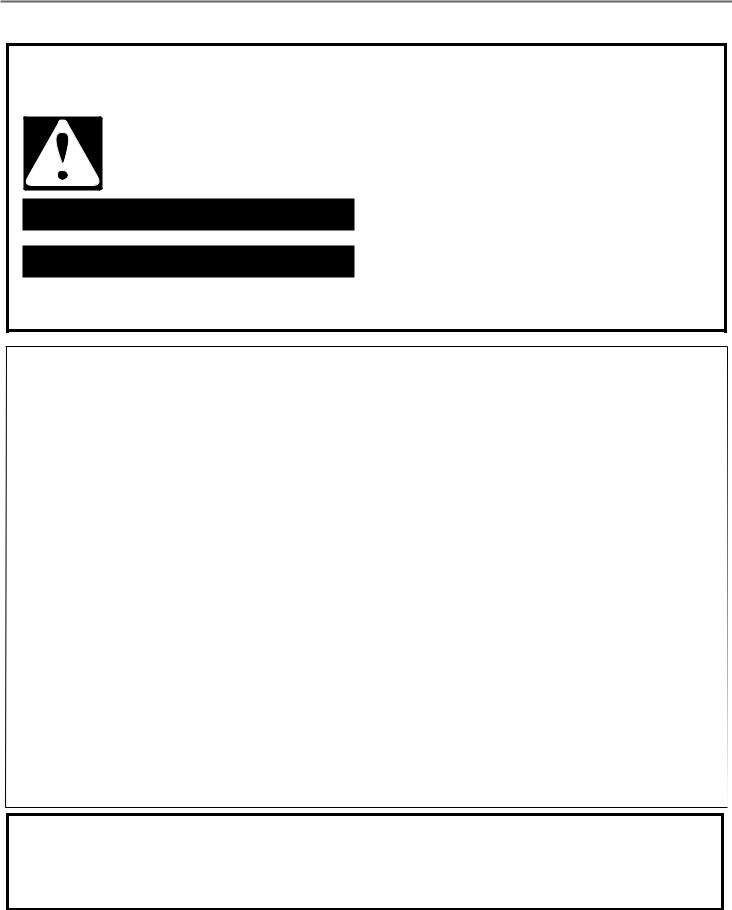
REFRIGERATOR SAFETY
Your safety and the safety of others are very important.
many important safety messages in this manual and on your appliance. Always read and obey all safety
safety alert symbol.
alerts you to potential hazards that can kill or hurt you and others.
messages will follow the safety alert symbol and either the word “DANGER” or “WARNING.” mean:
 DANGER
DANGER  WARNING
WARNING
You can be killed or seriously injured if you don't immediately follow instructions.
You can be killed or seriously injured if you don't follow instructions.
All safety messages will tell you what the potential hazard is, tell you how to reduce the chance of injury, and tell you what can happen if the instructions are not followed.
IMPORTANT SAFETY INSTRUCTIONS
WARNING: To reduce the risk of fire, electric shock, or injury when using your refrigerator, follow these basic precautions:
■Plug into a grounded (earthed) outlet.
■Do not remove ground prong.
■Do not use an adapter.
■Do not use an extension cord.
■Disconnect power before servicing.
■Replace all parts and panels before operating.
■Remove doors from your old refrigerator.
■Use nonflammable cleaner.
■Do not store or use petrol, flammable liquids or gas in the vicinity of this or other electrical appliances. The fumes can cause fires or explosions.
■Do not store explosive substances such as aerosol cans with a flammable propellant in this refrigerator.
■Do not use or place electrical devices inside the refrigerator compartments if they are not of the type expressly authorized by the manufacture.
■Use two or more people to move and install refrigerator.
■Disconnect power before installing ice maker (on ice maker kit ready models only).
■A qualified service technician must install the water line and ice maker. See installation instruction supplied with
ice maker kit IC13B for complete details.
■Connect to a potable water supply only.
■Use a sturdy glass when dispensing ice (on some models).
■This appliance is not intended for use by persons (including children) with reduced physical, sensory or mental capabilities, or lack of experience and knowledge, unless they have been given supervision or instruction concerning use of the appliance by a person responsible for their safety.
■Children should be supervised to ensure that they do not play with the appliance.
■To avoid the risk of children becoming trapped and suffocating, do not allow them to play or hide inside the refrigerator.
■If the power supply cord is damaged, it must be replaced by the manufacturer or its service agent or a similarly qualified person.
SAVE THESE INSTRUCTIONS
State of California Proposition 65 Warnings:
WARNING: This product contains one or more chemicals known to the State of California to cause cancer.
WARNING: This product contains one or more chemicals known to the State of California to cause birth defects or other reproductive harm.
2
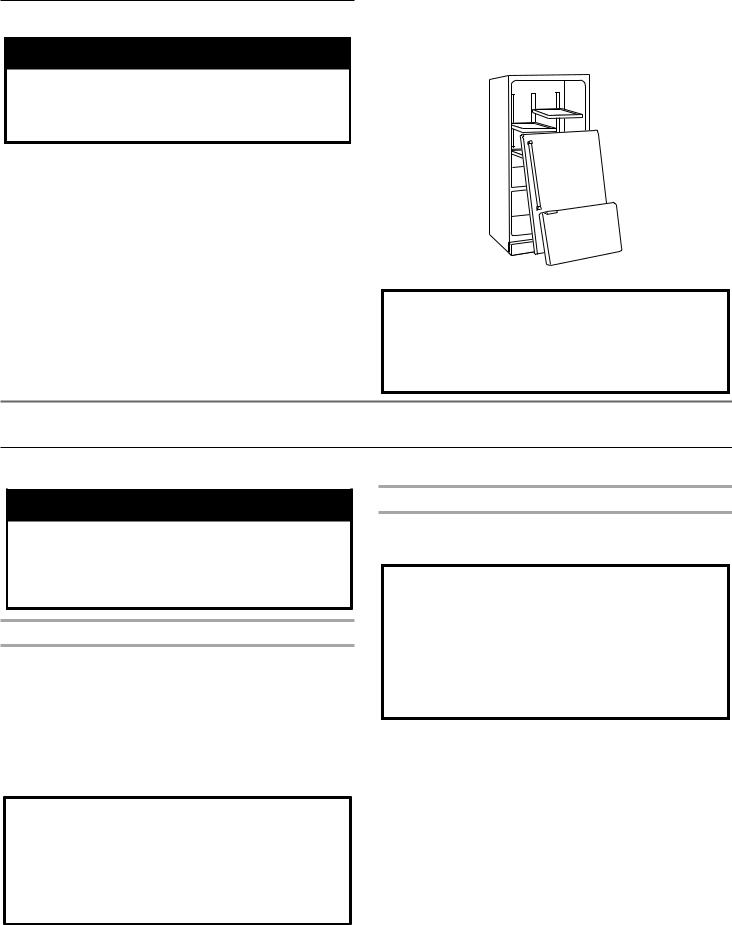
Proper Disposal of Your Old Refrigerator
 WARNING
WARNING
Suffocation Hazard Remove doors from your old refrigerator.
Failure to do so can result in death or brain damage.
IMPORTANT: Child entrapment and suffocation are not problems of the past. Junked or abandoned refrigerators are still dangerous –even if they will sit for “just a few days.” If you are getting rid
of your old refrigerator, please follow these instructions to help prevent accidents.
Before You Throw Away Your Old Refrigerator or Freezer:
■■ Take off the doors.
■■ Leave the shelves in place so that children may not easily climb inside.
Important information to know about disposal of refrigerants:
Dispose of refrigerator in accordance with Federal and Local regulations. Refrigerants must be evacuated by a licensed, EPA certified refrigerant technician in accordance with established procedures.
INSTALLATION INSTRUCTIONS
Unpack the Refrigerator
 WARNING
WARNING
Excessive Weight Hazard
Use two or more people to move and install refrigerator.
Failure to do so can result in back or other injury.
Remove the Packaging
■■ Remove tape and glue residue from surfaces before turning on the refrigerator. Rub a small amount of liquid dish soap over the adhesive with your fingers. Wipe with warm water and dry.
■■ Do not use sharp instruments, rubbing alcohol, flammable fluids, or abrasive cleaners to remove tape or glue. These products can damage the surface of your refrigerator. For more information, see “Refrigerator Safety.”
Clean Before Using
After you remove all of the packaging materials, clean the inside of your refrigerator before using it. See the cleaning instructions in “Refrigerator Care.”
Important information to know about glass shelves and covers:
Do not clean glass shelves or covers with warm water when they are cold. Shelves and covers may break if exposed to sudden temperature changes or impact, such as bumping. Tempered glass is designed to shatter into many small, pebble-size pieces. This is normal. Glass shelves and covers are heavy. Use both hands when removing them to avoid dropping.
■■ Dispose of/recycle all packaging materials.
When Moving Your Refrigerator:
Your refrigerator is heavy. When moving the refrigerator for cleaning or service, be sure to cover the oor with cardboard or hardboard to avoid oor damage. Always pull the refrigerator straight out when moving it. Do not wiggle or “walk” the refrigerator when trying to move it, as oor damage could occur.
3
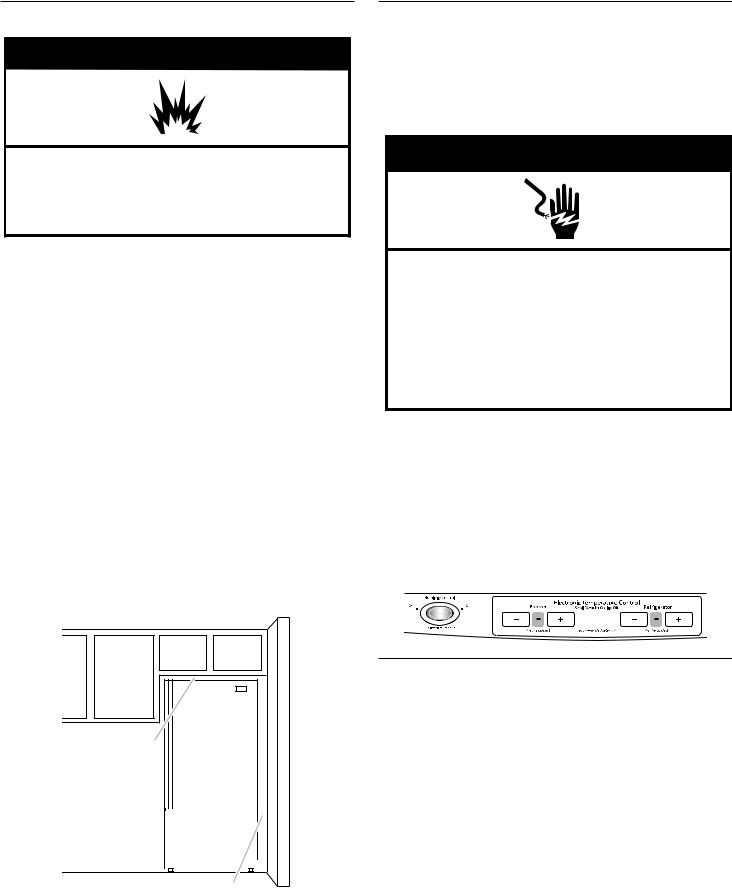
Location Requirements
 WARNING
WARNING
Explosion Hazard
Keep ammable materials and vapors, such as gasoline, away from refrigerator.
Failure to do so can result in death, explosion, or re.
IMPORTANT: This refrigerator is designed for indoor, household use only.
This appliances is intended to used in household and similar applications such as:
■■ Staff kitchen areas in shops, office and other working environments,
■■ Farm houses and by clients in hotels, motels and other residential type environments,
■■ Bread and breakfast type environments,
■■ Catering and similar non-retail applications.
To ensure proper ventilation for your refrigerator, allow for ¹⁄2" (1.25 cm) of space on each side and at the top. Allow for 1" (2.54 cm) of space behind the refrigerator. If your refrigerator has an ice maker, allow extra space at the back for the water line connections. When installing your refrigerator next to a fixed wall, leave 2¹⁄2" (6.3 cm) minimum on the hinge side (some models require more) to allow for the door to swing open.
NOTE: This refrigerator is intended for use in a location where the temperature ranges from a minimum of 55°F (13°C) to a maximum of 110°F (43°C). The preferred room temperature range for optimum performance, which reduces electricity usage and provides superior cooling, is between 60°F (15°C) and 90°F (32°C). It is recommended that you do not install the refrigerator near a heat source, such as an oven or radiator.
Electrical Requirements
Before you move your refrigerator into its final location, it is important to make sure you have the proper electrical connection.
If the supply cord is damaged, it must be replaced by the manufacturer or its service agent or a similarly qualified person. Do not use a cord that shows cracks or abrasion damage along its length or at either the plug or connector end.
 WARNING
WARNING
Electrical Shock Hazard Plug into a grounded 3 prong outlet. Do not remove ground prong.
Do not use an adapter.
Do not use an extension cord.
Failure to follow these instructions can result in death, fire, or electrical shock.
Recommended Grounding Method
A 115 volt, 60 Hz, AC only 15 or 20 A fused, grounded electrical supply is required. It is recommended that a separate circuit serving only your refrigerator and approved accessories be provided. Use an outlet that cannot be turned off by a switch. Do not use an extension cord.
NOTE: Before performing any type of installation, cleaning, or removing a light bulb, turn Cooling OFF, and then disconnect the refrigerator from the electrical source. When you have finished, reconnect the refrigerator to the electrical source and turn Cooling ON. See “Using the Control(s).”
Water Supply Requirements
Gather the required tools and parts before starting installation. Read and follow the instructions provided with any tools listed here.
|
¹⁄ " (1,25 cm) |
|
|
|
|
TOOLS NEEDED: |
|
|
||||
|
|
|
|
|
|
|
|
|
|
■■ 7/16" and 1/2" Open-end or |
■■ |
1/4" Drill bit |
|
|
|
|
|
|
|
|
|
|
|||
|
|
|
|
|
|
|
|
|
||||
|
|
|
|
|
|
|
|
|
||||
|
|
|
|
|
|
|
|
|
|
two adjustable wrenches |
||
|
|
|
|
|
|
|
|
|
|
■■ |
Cordless drill |
|
|
|
|
|
|
|
|
|
|
|
|
||
|
|
|
|
|
|
|
|
|
IMPORTANT: |
|
|
|
|
|
|
|
|
|
|
|
|
|
|
||
|
|
|
|
|
|
|
|
|
■■ Connect to potable water supply only. |
|||
|
|
|
|
|
|
|
|
|
|
|
||
|
|
|
|
|
|
|
|
|
|
Do not use with water that is microbiologically unsafe or |
||
|
|
|
|
|
|
|
|
|
|
|||
|
|
|
|
|
|
|
|
|
||||
|
|
|
|
|
|
|
2¹⁄ " (6,3 cm) |
|
of unknown quality without adequate disinfection before |
|||
|
|
|
|
|
|
|
|
or after the system. Systems certified for cyst reduction |
||||
|
|
|
|
|
|
|
|
|
|
|||
|
|
|
|
|
|
|
|
|
|
may be used on disinfected waters that may contain |
||
|
|
|
|
|
|
|
|
|
|
filterable cysts. |
|
|
|
|
|
|
|
|
|
|
|
|
|
|
|
4

■■ All installations must meet local plumbing code requirements.
■■ Do not use a piercing-type or 3/16" (4.76 mm) saddle valve which reduces water flow and clogs more easily.
■■ Use copper tubing and check for leaks. Install copper tubing only in areas where the household temperatures will remain above freezing.
■■ For models with water filters, the disposable water filter should be replaced at least every 6 months.
Water Pressure
A cold water supply with water pressure of between 35 and 120 psi (241 and 827 kPa) is required to operate the water dispenser and ice maker. If you have questions about your water pressure, call a licensed, qualified plumber.
Reverse Osmosis Water Supply
IMPORTANT: The pressure of the water supply coming out of a reverse osmosis system going to the water inlet valve of the refrigerator needs to be between 35 and 120 psi (241 and 827 kPa).
If a reverse osmosis water filtration system is connected to your cold water supply, the water pressure to the reverse osmosis system needs to be a minimum of 40 to 60 psi (276 to 414 kPa).
If the water pressure to the reverse osmosis system is less than 40 to 60 psi (276 to 414 kPa):
■■ Check to see whether the sediment filter in the reverse osmosis system is blocked. Replace the filter if necessary.
■■ Allow the storage tank on the reverse osmosis system to refill after heavy usage.
■■ If your refrigerator has a water filter, it may further reduce the water pressure when used in conjunction with a reverse
osmosis system. Remove the water filter. See “Water Filtration System.”
If you have questions about your water pressure, call a licensed, qualified plumber
Connect the Water Supply
Read all directions before you begin.
IMPORTANT:
■■ Plumbing shall be installed in accordance with the International Plumbing Code and any local codes and ordinances.
■■ The gray water tubing on the back of the refrigerator (which is used to connect to the household water line) is a
PEX(cross-linked polyethylene) tube. Copper and PEX tubing connections from the household water line to the refrigerator are acceptable, and will help avoid off-taste or odor in your ice or water. Check for leaks.
If PEX tubing is used instead of copper, we recommend the following Whirlpool Part Numbers:
W10505928RP (7 ft [2.14 m] jacketed PEX), 8212547RP (5 ft [1.52 m] PEX), or W10267701RP (25 ft [7.62 m] PEX).
■■ Install tubing only in areas where temperatures will remain above freezing.
■■ If you turn on the refrigerator before the water line is connected, turn off the ice maker to avoid excessive noise or damage to the water valve.
Connect to Water Line
1.Unplug refrigerator or disconnect power.
2.Turn OFF main water supply. Turn ON nearest faucet long enough to clear line of water.
3.Find a 1/2" to 1¹⁄4" (12.7 mm to 31.8 mm) vertical cold water pipe near the refrigerator.
IMPORTANT:
■■ Make sure it is a cold water pipe.
■■ Horizontal pipe will work, but the following procedure must be followed: Drill on the top side of the pipe, not the bottom. This will help keep water away from the drill. This also keeps normal sediment from collecting in the valve.
4.Determine the length of copper tubing you need. Measure from the connection on the rear of the refrigerator to the water pipe. Add 7 ft (2.1 m) to allow for cleaning. Use 1/4" (6.35 mm) O.D. (outside diameter) copper tubing. Be sure both ends of copper tubing are cut square.
5.Using a cordless drill, drill a 1/4" hole in the cold water pipe you have selected.
|
A |
|
B |
|
C |
|
D |
|
E |
|
F |
|
G |
A. Cold water pipe |
E. Compression sleeve |
B. Pipe clamp |
F. Shutoff valve |
C. Copper tubing |
G. Packing nut |
D.Compression nut
6.Fasten the shutoff valve to the cold water pipe with the pipe clamp. Be sure the outlet end is solidly in the 1/4" drilled hole in the water pipe and that the washer is under the pipe clamp. Tighten the packing nut. Tighten the pipe clamp screws slowly and evenly so the washer makes a watertight seal. Do not overtighten.
7.Slip the compression sleeve and compression nut on the copper tubing as shown. Insert the end of the tubing into the outlet end squarely as far as it will go. Screw compression nut onto outlet end with adjustable wrench. Do not overtighten or you may crush the copper tubing.
8.Place the free end of the tubing in a container or sink, and turn ON the main water supply. Flush the tubing until water is clear. Turn OFF the shutoff valve on the water pipe.
5
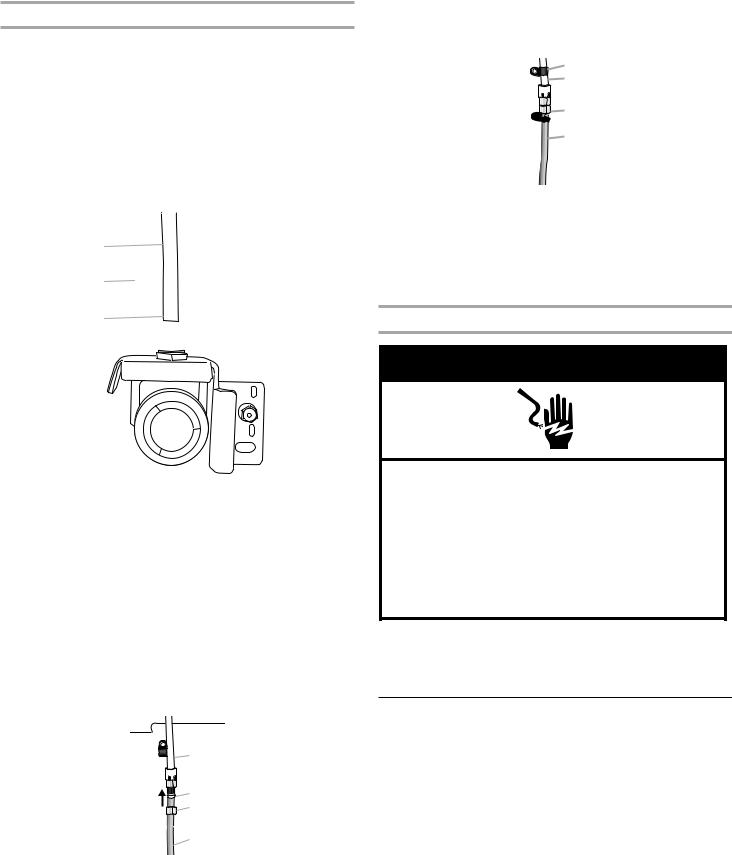
Connect to Refrigerator
Depending on your model, the water line may come down from the top or up from the bottom. Follow the connection instructions for your model.
Style 1
1.Remove plastic cap from water valve inlet port. Attach the copper tube to the valve inlet using a compression nut and sleeve as shown. Tighten the compression nut. Do not overtighten. Confirm copper tubing is secure by pulling on copper tubing.
2.Create a service loop with the copper tubing. Avoid kinks when coiling the copper tubing. Secure copper tubing to refrigerator cabinet with a “P” clamp.
A
B
C
D
A. Copper tubing |
C. Compression nut |
B. “P” clamp |
D. Compression sleeve |
3.Turn on water supply to refrigerator and check for leaks. Correct any leaks.
Style 2
1.Create a service loop (minimum diameter of 2 ft [61 cm]) with the copper tubing. Avoid kinks when coiling the copper tubing.
2.Remove the plastic cap from water valve inlet port. Place a compression nut and sleeve on the copper tubing.
3.Insert the end of the copper tubing into the water valve inlet port. Shape tubing slightly so that the tubing feeds straight into the port to avoid kinks.
4.Slide the compression nut over the sleeve and screw into the water valve inlet port.
|
A |
|
B |
|
C |
|
D |
A. Plastic water tubing |
C. Compression nut |
B. Sleeve |
D. Copper tubing |
5.Using an adjustable wrench, hold the nut on the plastic water line to keep it from moving. Then, with a second wrench turn the compression nut on the copper tubing counterclockwise to completely tighten. Do not overtighten.
|
A |
|
B |
|
C |
|
D |
A. “P” clamp |
C. Compression nut |
B. Plastic water line |
D. Copper tubing |
6.Check connection by pulling on copper tubing. Attach the plastic water line to the refrigerator cabinet with a “P” clamp.
7.Turn on water supply to the refrigerator and check for leaks. Correct any leaks.
Complete the Installation
 WARNING
WARNING
Electrical Shock Hazard Plug into a grounded 3 prong outlet. Do not remove ground prong.
Do not use an adapter.
Do not use an extension cord.
Failure to follow these instructions can result in death, fire, or electrical shock.
1. Plug into a grounded 3 prong outlet.
NOTE: Allow 24 hours to produce the first batch of ice. Discard the first three batches of ice produced. Allow 3 days to completely fill the ice contain
Refrigerator Door(s) and Drawer
TOOLS NEEDED: 5/16", 3/8", 1/4" hex head socket wrenches, a #2 Phillips screwdriver, and a flat-blade screwdriver.
IMPORTANT:
■■ Your refrigerator has a standard reversible refrigerator door with either a freezer door or freezer drawer, or French doors. Follow the instructions specific to the door style of your model.
■■ All graphics referenced in the following instructions are included later in this section after “Final Steps.” The graphics shown for the standard door are for a right-hand swing refrigerator (hinges factory installed on the right).
■■ If you only want to remove and replace the doors see “Remove Doors and Hinges” and “Replace Doors and Hinges.”
■■ Before you begin, turn the refrigerator control OFF, and remove food and adjustable door or utility bins from the doors.
6

Remove and Replace Handles
Refrigerator Door(s)
■■ To remove handles, use a 3/32" hex key to loosen the two setscrews located on the side of each handle. Pull the handle straight out from the door or drawer. Make sure you keep the screws for reattaching the handles. See Handle graphics 1 or 2.
■■ To replace handles, reverse the directions.
Freezer Drawer
■■ To remove handles, use a 3/32" hex key to loosen the two setscrews located under each handle. Pull the handle straight out from the door or drawer. Make sure you keep the screws for reattaching the handles. See Graphic 4.
■■ To replace handles, reverse the directions.
Freezer Door
■■ To remove handle, use a flat-blade screwdriver to remove the two screws fastening the handle to the freezer door. See Graphic 4.
■■ To replace handle, reverse the directions.
Remove Doors and Hinges
Standard Door
Freezer drawer models
1.Unplug refrigerator or disconnect power.
2.Keep the refrigerator door closed until you are ready to lift it free from the cabinet.
NOTE: Provide additional support for the door while the hinges are being moved. Do not depend on the door gasket magnets to hold the door in place while you are working.
3.Remove the parts for the top hinge as shown in Top Hinge graphic. Lift the refrigerator door free from the cabinet.
4.Remove the parts for the bottom hinge as shown in Bottom Hinge graphic.
Freezer door models
1.Unplug refrigerator or disconnect power.
2.Keep the freezer door closed until you are ready to lift it free from the cabinet.
NOTE: Provide additional support for the door while the hinges are being moved. Do not depend on the door gasket magnets to hold the door in place while you are working.
3.Remove the parts for the top hinge as shown in Top Hinge graphic. Lift the refrigerator door free from the cabinet.
4.Remove the center hinge pin and remove the hinge screws as shown in the Center Hinge graphic. Lift the freezer door free from the cabinet.
5.Remove the base grille by grasping the grille firmly with both hands and pulling it toward you.
6.Remove the parts for the bottom hinge as shown in Bottom Hinge graphic.
French Doors
 WARNING
WARNING
Electrical Shock Hazard Disconnect power before removing doors.
Failure to do so can result in death or electrical shock.
1.Unplug refrigerator or disconnect power.
2.Keep the refrigerator doors closed until you are ready to lift them free from the cabinet.
NOTE: Provide additional support for the refrigerator door while the hinges are being removed. Do not depend on the door gasket magnets to hold the door in place while you are working.
3.Starting with the right-hand side door, remove the parts for the top hinge as shown in Top Hinge graphic. Lift the refrigerator door from the bottom hinge pin.
4.Remove the hinge pin cover from the bottom hinge pin and keep it for later use. See Bottom Hinge graphic.
5.Before removing the left-hand side door, disconnect the wiring plug located on top of the top hinge by wedging a flat-blade screwdriver or your fingernail between the two sections. See Wiring Plug graphic.
NOTE: The green, ground wire remains attached to the hinge.
6.Remove the parts for the left-hand side door top hinge as shown in the Top Hinge graphic. Lift the door from the bottom hinge pin.
NOTE: Remove the hinge pin cover from the bottom hinge pin and keep it for later use. See Bottom Hinge graphic.
Reverse Door - Standard Door (optional)
IMPORTANT: If you want to reverse your door so it opens from the opposite side, follow these steps. If you are not reversing the door, see “Replace Door(s) and Hinges.”
Door Stop Screw |
Door Handle Seal Screw Front |
Flat-Head Handle Screw |
Cabinet Hinge Hole Plug |
Cabinet
1.Remove hinge screws from handle side and move them to opposite side. See Graphic 1.
Refrigerator door
1.Remove the refrigerator handle assembly as shown in Graphic 2. Keep all parts together.
2.Remove door handle seal screw front. Move to opposite side of refrigerator door as shown in Graphic 5.
3.Remove the door stop. Move it to the opposite side of the refrigerator door as shown in Graphic 3.
4.Attach refrigerator handle on opposite side of the refrigerator door with the two screws as shown in Graphic 2. Replace handle trim as shown.
5.Tighten all screws. Set aside the door until hinges and freezer compartment drawer are in place.
7
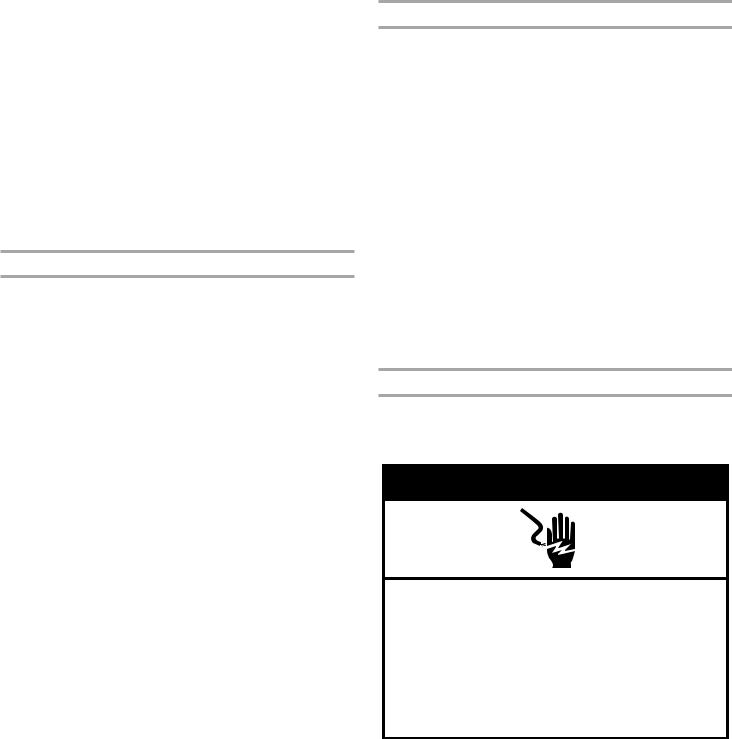
Freezer door
1.Remove the freezer handle assembly as shown in Graphic 4. Keep all parts together.
2.Remove door stop. Move to opposite side of freezer door as shown in Graphic 3.
3.Attach handle to opposite side of freezer door.
4.Tighten all screws. Set the door aside.
5.Remove the base grille by grasping the grille firmly with both hands and pulling it toward you.
NOTE: Place a shim under the bottom front edge of the refrigerator cabinet to take the weight off the roller brackets.
6.Remove the screws from both roller brackets. See Graphic 6.
7.Remove the hinge plate located behind the roller bracket and move it to the opposite side of the refrigerator. Move the
hinge pin and shim to the outside hole on the hinge plate. See Graphic 6.
Replace Doors and Hinges
Standard Door
NOTE: Graphics may be reversed if door swing is reversed. Freezer drawer models
1.Replace the parts for the bottom hinge as shown. Tighten screws.
NOTE: Provide additional support for the door while the hinges are being moved. Do not depend on the door gasket magnets to hold the door in place while you are working.
2.Assemble the parts for the top hinge as shown in Top Hinge graphic. Do not tighten screws completely.
3.Adjust the door so that the bottom of the refrigerator door is aligned with the top of the freezer drawer. Tighten all screws.
Freezer door models
1.Make sure the hinge plate is securely fastened behind the roller bracket and that the hinge pin is inserted into the outside hole. Fully tighten all roller bracket screws. See Graphic 6.
2.Remove the shim that you placed under the front edge of the refrigerator cabinet. Replace the freezer door.
NOTE: Provide additional support for the door while the hinges are being moved. Do not depend on the door gasket magnets to hold the door in place while you are working.
3.Assemble the parts for the center hinge as shown in the Center Hinge graphic, and tighten all the screws. Replace the refrigerator door.
4.Assemble the parts for the top hinge as shown in the Top Hinge graphic. Do not tighten the screws completely.
5.Adjust the doors so that the bottom of the refrigerator door is aligned with the top of the freezer door. Tighten all screws.
French Doors
1.Assemble the parts for the top hinges as shown in Top Hinge graphic. Do not tighten the screws completely.
2.Replace the parts for the bottom hinges as shown in Bottom Hinge graphic. Tighten screws. Replace the refrigerator doors.
NOTE: Provide additional support for the refrigerator doors while the hinges are being moved. Do not depend on the door gasket magnets to hold the doors in place while you are working.
3.Align each door so that the bottom of the refrigerator door aligns evenly with the top of the freezer drawer. Tighten all screws.
4.Reconnect the wiring plug on top of the left-hand side refrigerator door.
5.Replace the top hinge covers.
Remove and Replace Freezer Drawer
IMPORTANT:
■■ Two people may be required to remove and replace the freezer drawer.
■■ All graphics are included later in this section after “Final Steps.”
Remove Drawer Front
1.Open the freezer drawer to full extension.
2.Loosen the four screws attaching the drawer glides to the drawer front. See Drawer Front Removal graphic.
NOTE: Loosen screws three to four turns. Keep the screws in the drawer front.
3.Lift drawer front upward and off the screws. See Drawer Front Removal graphic.
Replace Drawer Front
1.Slide the drawer glides out of the freezer compartment. Insert the screws in the top of the drawer front into the slots in the drawer brackets. See Drawer Front Replacement graphic.
2.Pull the drawer brackets toward you to insert the two screws in the bottom of the drawer front into the brackets. See Drawer Front Replacement graphic.
3.Completely tighten the four screws.
Final Steps
1.Check all holes to make sure that hole plugs and screws are in place. Reinstall top hinge cover as shown in Top Hinge graphic.
2.Replace the base grille.
 WARNING
WARNING
Electrical Shock Hazard Plug into a grounded 3 prong outlet. Do not remove ground prong.
Do not use an adapter.
Do not use an extension cord.
Failure to follow these instructions can result in death, fire, or electrical shock.
3.Plug into a grounded 3 prong outlet.
4.Return all removable door parts to door and food to refrigerator.
8
